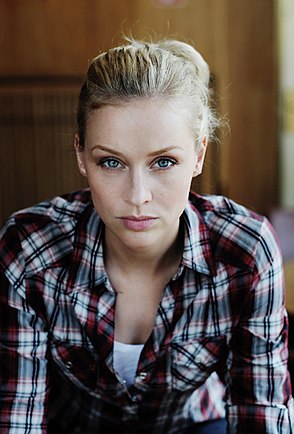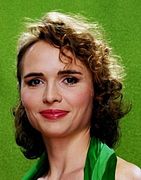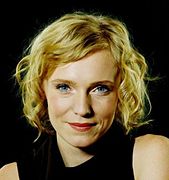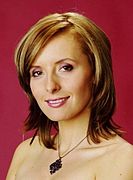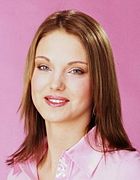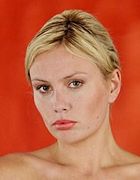Headshot (photography)

Headshots are a genre of their own within modern portrait photography , which is widely used in digital media . The recordings are usually made in a controlled environment, such as a studio, with the person making direct eye contact with the camera. The cropping of the image is very tightly centered on the head and face, with little room for the rest of the body. Eye-catching make-up and jewelry are omitted so that nothing distracts from the person's expression. Because the purpose of a headshot is to create a connection between the viewer and the person depicted. The headshot often serves as a substitute in social media and gives virtual existence there a face. In contrast to the business portrait, in which accessories that are related to the job or other additional objects are often part of the photo, the headshot is only about the personality and not about your activity or position. While a portrait has elements that are far from the face, such as B. may contain hands in the picture, this is undesirable for headshots.
The term is usually used in the media industry . Headshots are used by artists, writers, actors, directors, models, musicians and in comparable guilds to apply for a job or a project, to supplement their personal professional website or to illustrate short biographies (for example in theater programs). In addition, the portrait photographs on the About Us pages of (business) companies, universities, political parties, etc. as well as close-ups of familiar faces for advertising posters are often referred to as headshots (not only in English-speaking countries).
Entertainment industry
In the entertainment industry, i. H. in theater , film and television , applying actors, singers, models, entertainers and occasionally also the artists "behind the scenes" - directors, authors etc. - usually also give a headshot in addition to a résumé or a list of their relevant projects expected. Since these are (also) application photos, these headshots are usually more artistically designed than other portraits (photos): They should (literally) show the person depicted in the best possible light.
Actor headshots
- Difference headshot (left) - portrait (right)
... and Verena Mundhenke
For headshots, artists often don't look into the center of the camera, sometimes not at all. Performing artists often have headshots made in various postures and with different facial / gestural expressions in order to give potential employers a preliminary impression of the range of emotional expression that can be expected. This form of headshots also looks ( glances called). It is sometimes common for actors to have different and correspondingly new headshots made, depending on the role profile, but in the case of applications following one another, these differences often only consist of a change of wardrobe. Can be seen in the Headshots the shoulders of the person represented, called the shots three-quarter shots ( three-quarter shots ). For a long time, headshots were mostly made in black and white, some photographers still use this technique; However, colored headshots are more common today.
In most cases, headshots are sent as digital files or used for online appearances. If a printout is also required, this is usually done in the 8 × 10 ″ format for headshots by actors . Exceptions are advertising photos for posters and press or wall pictures for the entrance halls of theaters. In order to meet these requirements, headshots are created from the outset as particularly high-resolution files. Actor headshots are usually not photo prints, but are typically printed using lithographic or laser processes.
The main objective of actor headshots is the ability to identify quickly. That is why the most important function of the photo is to represent the person portrayed as adequately as possible. Theater headshots are usually very neutral -looking recordings of the actor, on which their facial features are particularly easy to see.
Headshots should represent the appearance and work of a person as possible at the current point in time and at the same time highlight their best qualities. For this reason, a new haircut or tint is often associated with the need for a new headshot, especially for actors. In contrast to, for example, application photos for other professions, it is also required that existing skin structures, scars, wrinkles, cosmetic blemishes, etc. are clearly visible and not digitally removed as is usual. Only short-term skin blemishes such as pimples or new, only superficial wounds may be touched up.
Modeling headshots
Modeling headshots (American English: mode l ing ), sometimes used synonymously with comp cards or tear sheets in English-speaking countries, are a collection of photos taken by models together with their CV, their name and the required statistics (body measurements, etc. ) must be submitted in the application process. Mostly these are colored prints, but in some countries, such as the United Kingdom, black and white photographs are also common. In addition to the application processes, they also use models for the actual assignments. A close-up, as is done in the headshot, is often required in the application process in order to clearly show the applicant's complexion, especially when taking photos for beauty products. Scars, eczema and other skin blemishes can be professionally retouched for this purpose, unlike, for example, actor headshots, this option is used excessively in this profession. This means that the photos can also be used for artist portfolios and websites beyond the application process.
Modeling headshots are usually used (in the application process) for:
- Comp cards and tear sheets
- Television advertisement for skin care products
- Magazine advertisements for creams and other skin or hair care products
- Online appearances of product manufacturers and model agencies
- Model portfolios
Comp-Cards are part of the "marketing material" and are one of the most important building blocks of a modeling career. They are printed on both sides in a format of approximately 5½ ″ × 8 ″. Almost all Comp-Cards are color prints, sometimes black and white photographs can also be added. Every model can add four to five photos to their comp card, at least one of these images is always a headshot.
Photographer styles
Unlike in the business sector (see next section), in which the exact details of the form, content and background of the headshots are often regulated by the client or employer, some photographers develop their own style in the artistic environment, which - in addition to taking into account the individual Characteristics of the photographed person - has a decisive influence on the design of the headshots. If such photographers or studios have developed a certain degree of awareness, their customers sometimes come to them because of these trademarks. Photographers who are also valued as artists and who are known for one or more specific portrait photography styles are, for example, Andy Gotts (black and white headshots with strongly emotional, sometimes grimacing facial expressions); David LaChapelle (known for so-called "kitsch-pop-surrealism"); Rory Lewis (specializes in headshots with particularly clear facial contours in warm light and against very dark, simple backgrounds); Martin Schoeller (known for “hyper-realistic” extreme close-ups of the faces).
One of the most important exponents of headshot photography is the New York photographer Peter Hurley. His style is unmistakable and is characterized by reserved backgrounds in gray, white or black and he pays particular attention to the details. Much more important than this, however, is that he works with the people in front of the camera until they have forgotten the camera and can act naturally and relaxed. This creates natural and convincing headshots that lay the foundation for a trusting relationship with the viewer. On the website of the headshot crew he founded, more than 13,000 photographers from all over the world are listed with their respective locations. From this, anyone can search for the closest photographer in terms of distance who specializes in headshots.
- Some studios give their headshots a recognition value, for example through recurring color schemes: example Foksal (Warsaw, Poland)
Economics
Corporate headshots ( corporate headshots ) are portraits that are intended mostly for digital access and are used to profile pages of social media websites of companies on digital business cards, etc.. Headshots are used in the economic sector and in particular on company websites for branding purposes (see also the next section ) and to present the management team, and in large companies they are often subject to strict manuals with guidelines for image design (dress code, backgrounds, ...). More commonly used here than in the headshot shapes listed above is black and white photography. In contrast to actor headshots, digital touch-ups are naturally used for these photos, ie wrinkles, small scars and skin imperfections are largely retouched. At the same time, facial features that are perceived as "natural" or "sympathetic" (laugh lines around the eyes, dimples on the cheeks and chin, suggested "seriousness" wrinkles on the forehead) should not be lost through digital processing, as is sometimes the case with modeling headshots is the case in which the appearance or the perfection of the skin structure is usually in the foreground.
Company headshots serve a variety of purposes:
- LinkedIn : Personal and company profiles
- Facebook : Personal and company profiles
- "About us" or "About us" pages
- Professional resume
- Company catalogs, brochures and promotional materials
- Company websites and publications for internal and external access
- Press and other releases
- Marketing materials
- (Newspaper) articles
- "Author pages" for (book) publications
Branding headshots
- Examples of branding headshots
So-called branding headshots are usually specific company or business headshots. The photo should not primarily illustrate the individuality of the person shown, but rather their affiliation with a certain brand ( brand ). This can be done by uniformly designing all photos of the employees of a company, by a specific dress code or by integrating logos or other brand-typical symbols and objects in the photo. Employees of large companies and agencies often receive a detailed manual with the exact requirements for the corresponding headshot.
Web links
Individual evidence
- ^ Peter Kolonia: Tips From a Pro: Peter Hurley on High-End Headshot Photography . Popular Photography. April 9, 2015. Retrieved April 17, 2015.
- ↑ Michael Sanville: Taking Your Best Shot . Backstage. February 25, 2011. Retrieved April 17, 2015.
- ↑ David Locke: What is a corporate headshot? . Business professional specialized in headshot photography. October 26, 2017. Retrieved April 21, 2015.

